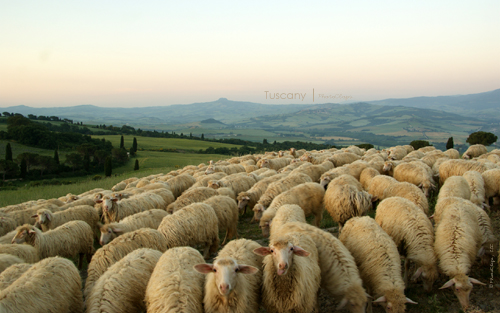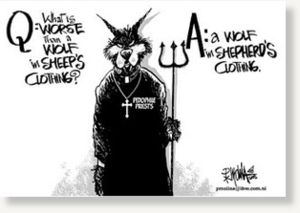“If liberty means anything at all, it means the right to tell people what they do not want to hear.” - George Orwell

There is a reason for Catholics all over the world to be referred to as sheep. In the context of his times, Jesus began to be referred to as the Shepherd and his followers sheep or little lambs. He himself used the simile of the shepherd and his flock in his talks to the uneducated Jewish masses to make them understand Yahweh's love for His Chosen People. Times have changed; still the terminology continues to be in use. The reason these days seems quite different: it is the continued sheepish behaviour exhibited by the majority of Catholics.

A few weeks back, a ‘sheepish’ incident took place in my neighbourhood. My neighbour had tied a goat to a stake in an empty plot next door. Its little lamb was left loose to roam free. Somehow, the mother goat got untangled, and seeing the grass greener on the other side, climbed on to the wall and jumped into the next yard. Unfortunately, it landed in a well close to the wall, and its kid, with its sheepish brain, jumped right after its mother as well. The deathly bleating caught the neighbours'’ attention and both were pulled out to safety.
I must confess that till recently I too was one of the sheep. In fact, the years I spent as a seminarian made me one par excellence. It takes years of self-debriefing to change that mind-set. After retiring, with time becoming a luxury, I began to read up on the history of the Catholic Church – from its birth after the death of Jesus to its current state. It came as a big shock, brought up as I was on a diet of absolutely certain ‘dogmatic beliefs’, to learn: that the present Church was founded not by Jesus, but by St. Paul; that the original Church led by James, the real brother of Jesus (not cousin as claimed by Catholic Church to defend Mary’s virginity) died a natural death after the destruction of the Jerusalem temple in 70 A D; that there are three gods in One and one God in three; that Jesus’ virgin birth, his Resurrection, his Ascension, Mary’s physical Assumption, wine and bread turning into human blood and flesh and a host of such physical impossibilities are all copied from ancient myths, rituals and practices; that the Catholic Church is a big multinational establishment sailing on feudalistic lines in a sea of democratic practices. What baffled me was the ability of this Church to fool so many people for so long and still continue to do so!
As I delved deeper into the subject, I realised that the sheepish ‘blindly-follow-the-leader’ attitude of the vast majority of Catholics has been intentionally developed and purposefully instilled using a number of tactics. Fear stands out: fear of God’s anger, fear of priestly ‘curses’, fear of the unknowability of life after death, fear of the everlasting tortures of hell. Another useful technique is to present to the faithful myths and lies as truths. Repeat a lie million times and it becomes an eternal truth. The mother of all investment frauds is perpetuated by the Catholic Church: become its member, choose pain over pleasure and you will enjoy everlasting happiness after you die in a fantasy place called paradise.
A third technique is based on the dictum ‘knowledge is power’; if you keep the lambs in ignorance, you can keep them under control. One of the means used to oppose Luther, Calvin & Co was book censorship. In 1559 Pope Paul IV issued the first list of forbidden books, the Index Expurgatorius which included works by the humanist Erasmus, scientists Copernicus and Galileo as well as the Qur'an. In 1571 a Congregation of the Index was established to control and update the list. Canon Law now required the imprimatur (let it be published) and nihil obstat (nothing prohibited) to be printed on books allowed to be read by Catholics. This practice is still prevalent.

Galileo explains his discoveries to the Pope.

In 1521, William Tyndale, a brilliant protestant priest and linguist who could speak eight languages fluently, began translating the Bible into English. However, the Vatican did not want a wide readership of the New Testament. Access to the bible was reserved for the clergy, who could then interpret its message to suit the interests of Rome. In such circumstances, the translation of the Bible into English would be dangerous. Tyndale became a marked man; he was caught, tried as a heretic and garrotted by King Henry VIII at the behest of Rome.
A far more vicious and psychologically harmful technique used by the Church since its infant days to keep the little lambs under control has been to link ‘sex’ with ‘guilt’. Saul of Tarsus and Augustine of Hippo have been the two main proponents in the development and spread of this technique.
Based on the philosophy of Plato, Saul (canonized as St. Paul by voice vote) built his theology around an essentially dualistic view of the cosmos in which the earthly was denigrated in favour of the heavenly. Those who denied the body and lived a celibate life, placing emphasis on the higher spiritual things ‘above’, were viewed as holy and free from the taint of the lower material world ‘below’ (asceticism). He advocated celibacy as a higher spiritual way, though he did not absolutely forbid sex. According to Paul, marriage was an antidote for the spiritually weak who might be tempted toward sexual immorality.
Paul’s ideas were taken up by Augustine (354-430) of Hippo. In his youth he had led a life of debauchery. After his conversion to Christianity in 386, he developed a deep loathing and distrust of sex. His experience of sex was confined to illicit loves which left in his conscience a strong sense of guilt and misery. Extrapolating, he concluded that all sex, even in marriage, is wicked and sinful. He came to believe that God had condemned humankind to eternal damnation because of Adam’s ‘original sin’. This ‘inherited sin’ was passed down through ‘concupiscence’, the desire to take pleasure in sex rather than in God. Because we are born as sexual beings, we are sinners who deserve to burn in hell, and if we want to go to heaven, we must have sex only for procreation - and even then, God forbid, we should enjoy it. The man should embrace his wife as though she were a statue and the woman should recite: “I am not doing it for my pleasure but to give God a son.”
All this led to the elevation of virginity to the highest level of spirituality. For him the ideal marriage would be between two virgins. The institution of marriage was downgraded, since virginity was the ideal. This mode of thinking led him to conclude that the minister at the altar should also be celibate.
Augustine’s teachings were held as the basis of sexual morality for the next 1600 years. It is only recently that some form of recognition has been accorded to marriage as a loving union of two individuals. To the old genital approach to sexuality, the Catholic Church has added elements of mutual love and mutual aid; still the primary end of marriage is procreation.
There you have it. If you are nonsexual, you are spiritual!!! The consequences of this anti-natural mode of thinking, not found in the teachings of Jesus, but borrowed from Greek Philosophers, had wide ranging and dire consequences for the lives of Christians for centuries and will continue to do so for the foreseeable future. In the name of God, the belief that sex is dirty has perpetrated rampant cruelty, bigotry, and timidity; it has created religious sexual abuse in homes and in churches; it has generated intense shame about our bodies and desires; and it has fuelled the belief that parts of our bodies are dirty, fostering hatred of and confusion about pleasure.
Monasteries and religious congregations were founded on the idea that virginity and chastity were most pleasing in the eyes of Jesus and God. Priests and nuns took the vow of chastity, having been brainwashed during years of formation that the chaste life is a short cut to heavenly bliss. The Catholic Church stands accused of the psychological damage suffered by many in religious life forced to live against nature and for the guilt complex created in the consciences of little lambs in obeying dogmas based on outmoded moral philosophies of ancient men who were products of completely different social systems.
[Published in the January 2011 issue of Snehasandesham]

@unknown

No comments:
Post a Comment